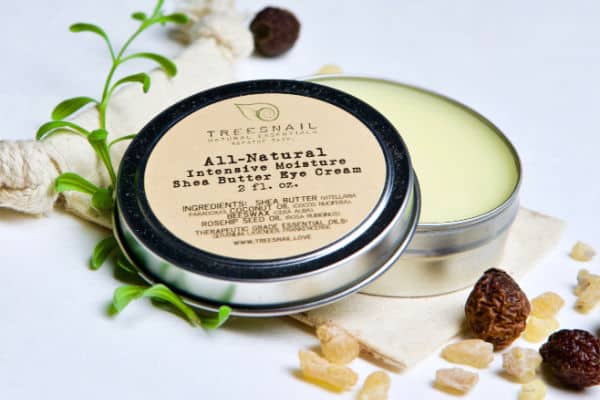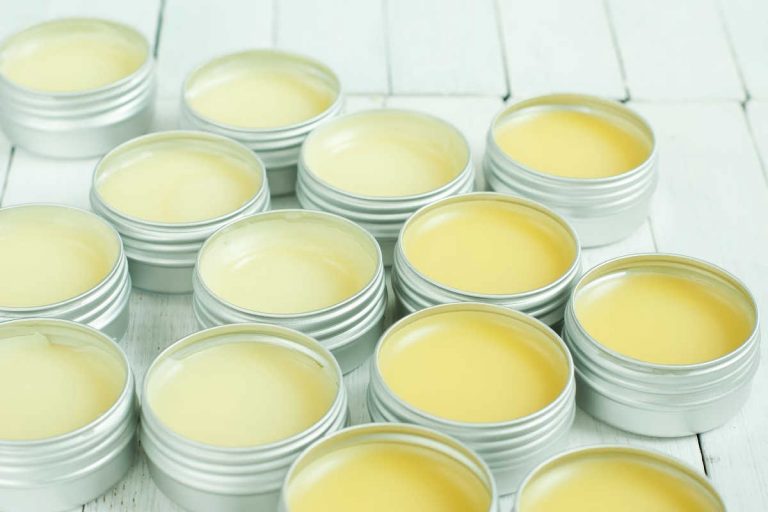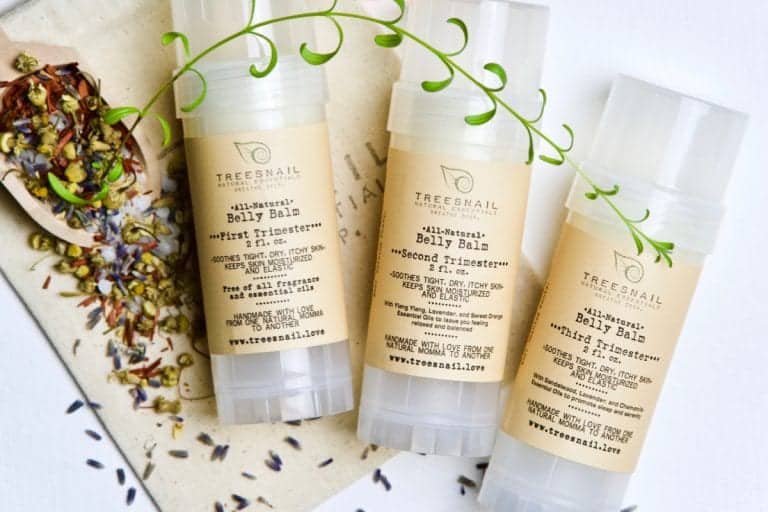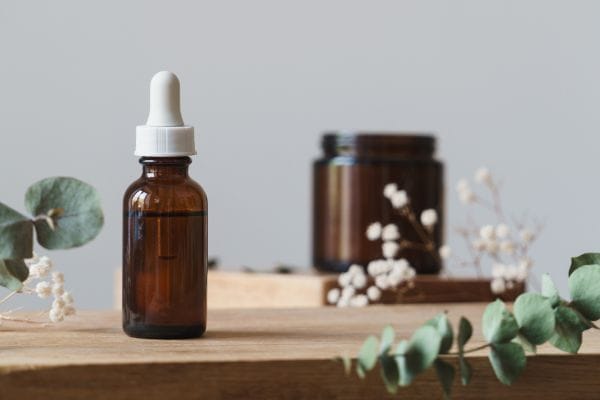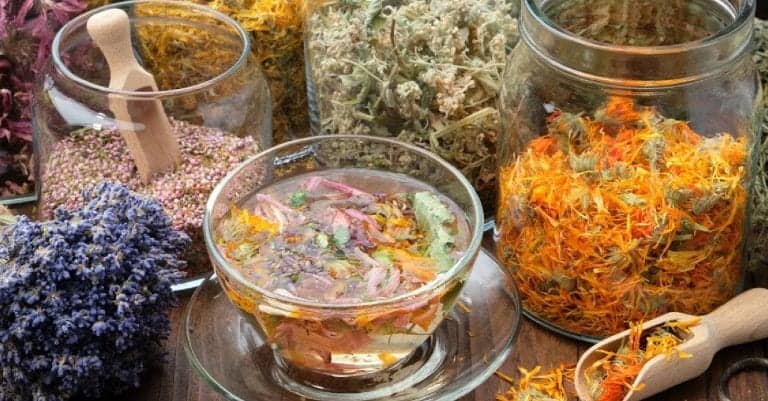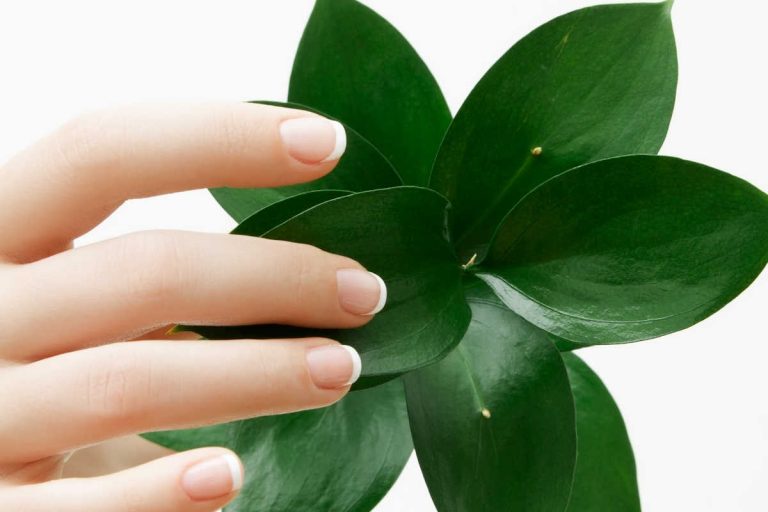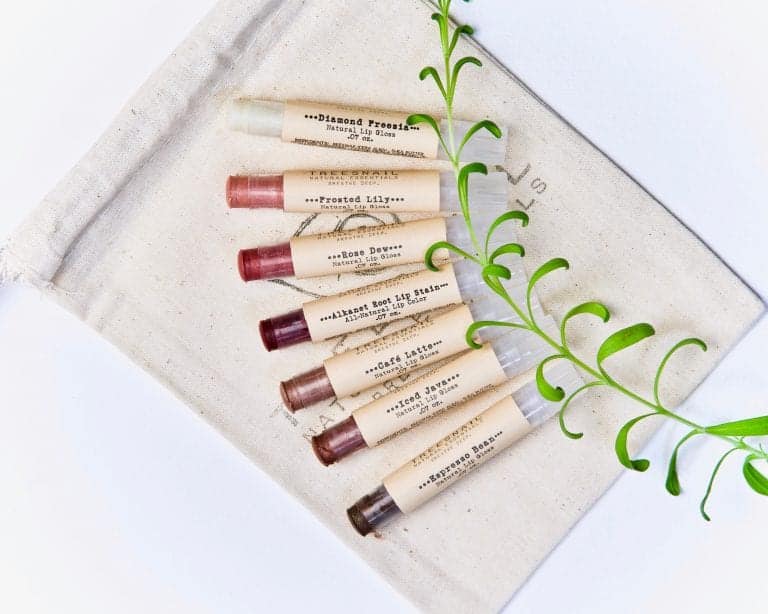If you’re looking for the perfect organic under-eye salve recipe to add to your handmade skin care line, this post is for you!
When priced correctly, this product can be super profitable (win for you!) WHILE helping your customers feel more confident about themselves because of how it can reduce dark circles and puffiness around their eyes (win for them!).
This all-natural recipe includes ingredients that are gentle on sensitive skin and contain none of the harmful chemicals and preservatives found in most store-bought brands.
In this post, you’ll learn how to create a customer-retaining organic under-eye salve recipe, as well as how to brand it to fit your specific skin care business target market.
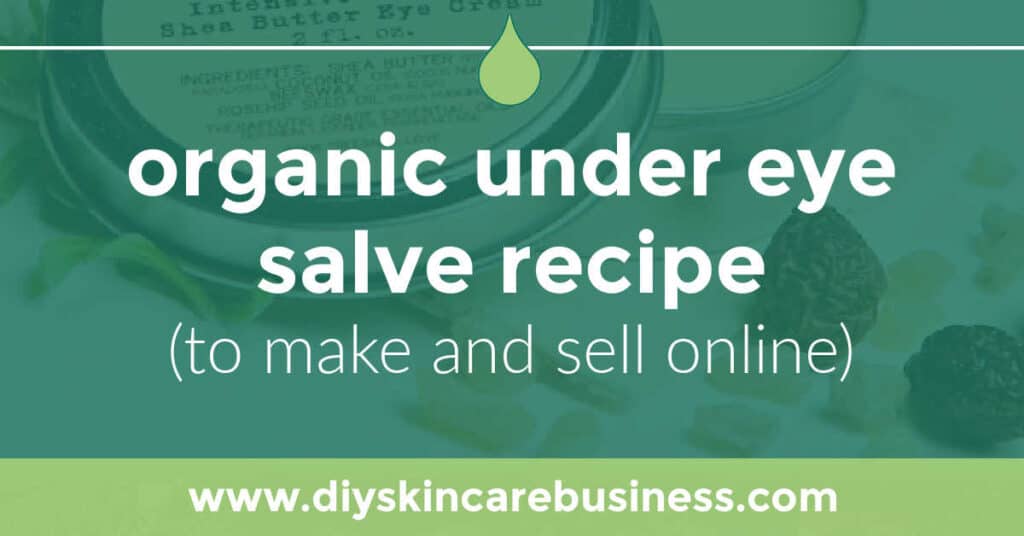
This post may contain affiliate links, meaning I get a commission if you decide to make a purchase through my links (at no cost to you). Please read the disclosure for more information.
What is an Under-Eye Salve?
A salve is an ointment used to promote healing of the skin or as protection, heavier in body than your typical cream or lotion (since it doesn’t include any water).
An under-eye salve specifically addresses the delicate skin underneath the eye to reduce puffiness and circles, deeply moisturize, and reduce the appearance of fine lines.
What causes dark circles and puffiness under the eyes?
Dark circles under the eyes are actually blue-ish veins that show through this thin skin, whereas puffiness is due to fluid accumulation (both of which occur when something in our body is off-balance).
Here are some of the most likely culprits:
Genetics
If one or both of your parents have dark circles under the eyes, you will likely have this issue too (sorry folks, nothing you can do about that!).
Lack of sleep
Dark circles may be due to not enough sleep or not getting enough restorative deep sleep cycles (delta sleep, aka slow-wave sleep).
Nutritional deficiencies
These could include Vitamin A, B2 (Riboflavin), Copper, Zinc and/or iron deficiency (anemia).
Allergies
This can include allergies to cosmetics and fragrances (which sometimes sneak under the radar), as well as environmental allergens such as pollen and dust.
Stress
Stress can result in a loss of soft tissue around the eyes due to collagen breakdown and fluid accumulation.
Excess salt intake
Eating salty foods can cause water retention which can lead to dark circles and puffiness.
Thyroid conditions
Hypothyroidism is associated with puffiness in the eyes, while hyperthyroidism may cause dryness which leads to dark circles.
A holistic approach
In order for your customers to have the best results from this under-eye salve recipe, also educate them on the importance of hydration, sleep, diet, and stress reduction.
Introducing your customers to holistic skincare, explaining how everything in the body is connected, and giving them tools to begin this wellness journey is one of the top joys of being a natural skincare entrepreneur!
Under-Eye Salve vs. Under-Eye Cream
Salves are anhydrous products, which means they are made without water.
This gives them a thicker consistency, longer shelf life, and more nourishing qualities that help to deeply moisturize and regenerate epithelial tissue.
Lotions and creams contain oil and water, which gives them a thinner consistency and requires chemical preservatives to keep them from going rancid.
Creating waterless products for your customer base is the safer option for long-term health.
How to Use Under-Eye Salve
Scoop a very small amount onto a pinkie or ring finger (a little of this goes a LONG way). Apply it gently to the under-eye area in an upward motion, taking care to not get it in the eye itself.
It is recommended to use under-eye salve as part of a nightly routine (rather than in the morning); it is very rich in moisturizing butters and can take a while to soak into the skin.
It is best practice to apply nightly skin care products in a ‘thin to thick’ order. For example:
- Cleanse the face first
- Apply light-weight toner second
- Apply medium-weight serum third, and
- Apply heaviest-weight salves last.
Supplies for Making Under-Eye Salve
Ingredients for DIY Organic Under-Eye Salve (and Their Benefits)
Organic Shea Butter
Shea butter is great for moisturizing and softening dry, rough and damaged skin.
Natural Shea Butter contains Vitamins A, E & F which are all antioxidants.
Vitamin A helps with cell turnover which makes skin look healthy, tight and fresh. It also helps with reducing wrinkles and fine lines.
Vitamin E is a strong antioxidant and prevents the skin from damage due to environmental stresses.
Vitamin F (aka Essential Fatty Acids) helps with cell turnover, which will reduce the appearance of wrinkles, as well as restore and maintain youthful vitality and glow to the skin.
Organic Coconut Oil
Coconut oil has been added to this formula to help with the absorption rate of the under-eye salve (melts upon contact with skin).
This is an excellent carrier for sensitive skin, helps retain moisture, and has antibacterial and antimicrobial properties.
Organic Rosehip Oil
Rosehip oil is deeply moisturizing, and a great carrier to use for cell regeneration in mature and dry skin.
Note that this carrier oil has a super short shelf life – buy in small quantities to provide your customer with a fresh product.
Organic Beeswax
Beeswax is included in this under-eye salve recipe to help solidify the formula and keep it from melting while in transit to your customer during higher temperatures.
Beeswax also protects the skin barrier without clogging pores and aids in healing and skin development.
Step-by-Step Organic Under-Eye Salve Recipe (to Sell Online)
Prepare ingredients by measuring out the butters, oils, and beeswax with the ramekins and scale.
- 2 oz. Organic Shea Butter (Vitellaria paradoxa)
- 1 oz. Organic Coconut Oil (Cocos nucifera)
- .5 oz. Organic Rosehip Oil (Rosa rubiginosa)
- .333 oz. Organic Beeswax (Cera alba)
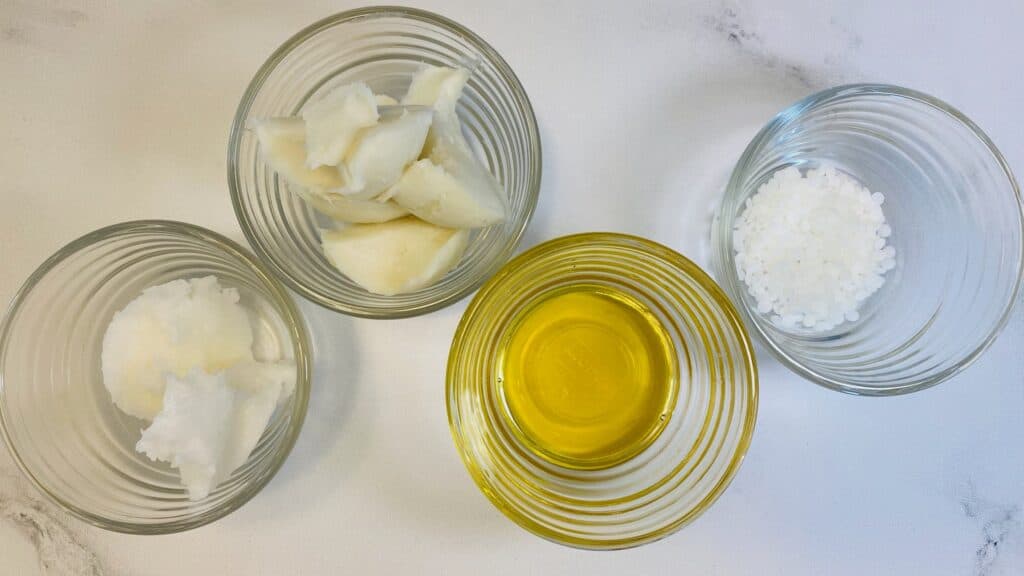
Fill saucepan with water and place the double boiler on top, making sure that it is partially submerged in the water.
Turn your heating element on to medium-low; if it starts to simmer, turn down the heat so that water does not enter the doubler boiler.
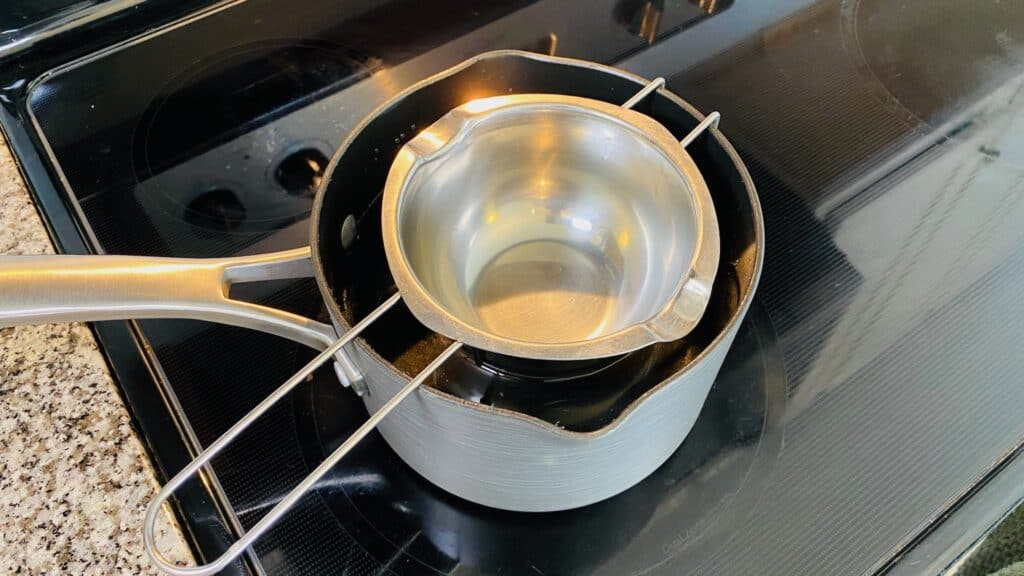
Add organic beeswax to the double boiler and stir with a glass stir rod until melted.
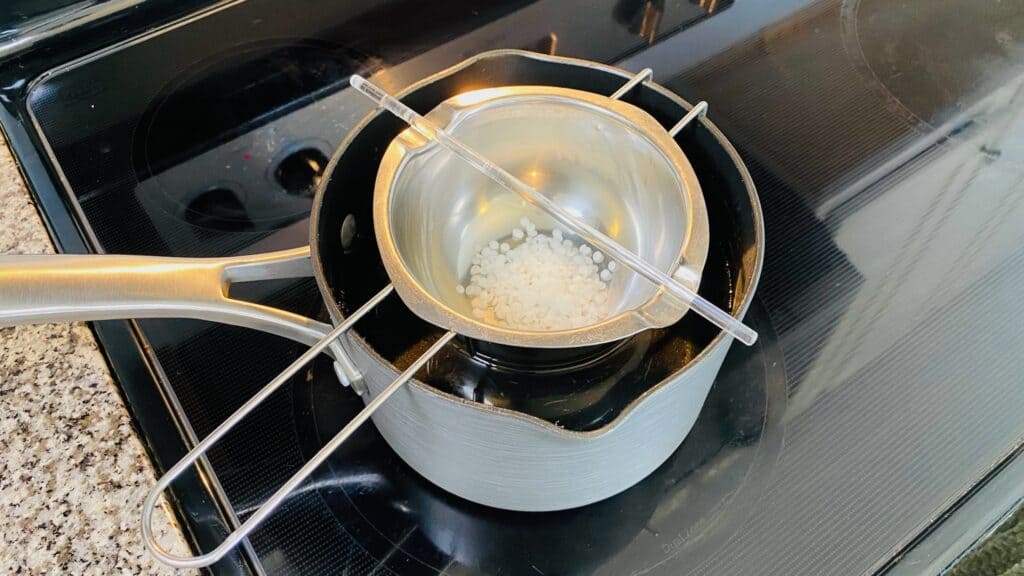
Add organic coconut oil and stir until melted.
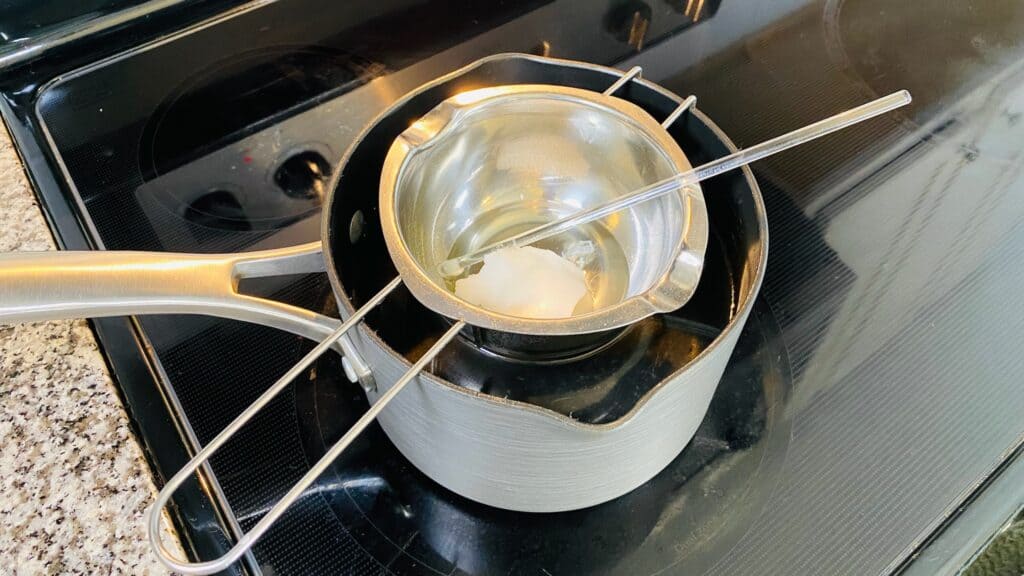
Remove from heat, add the organic rosehip oil, and stir.
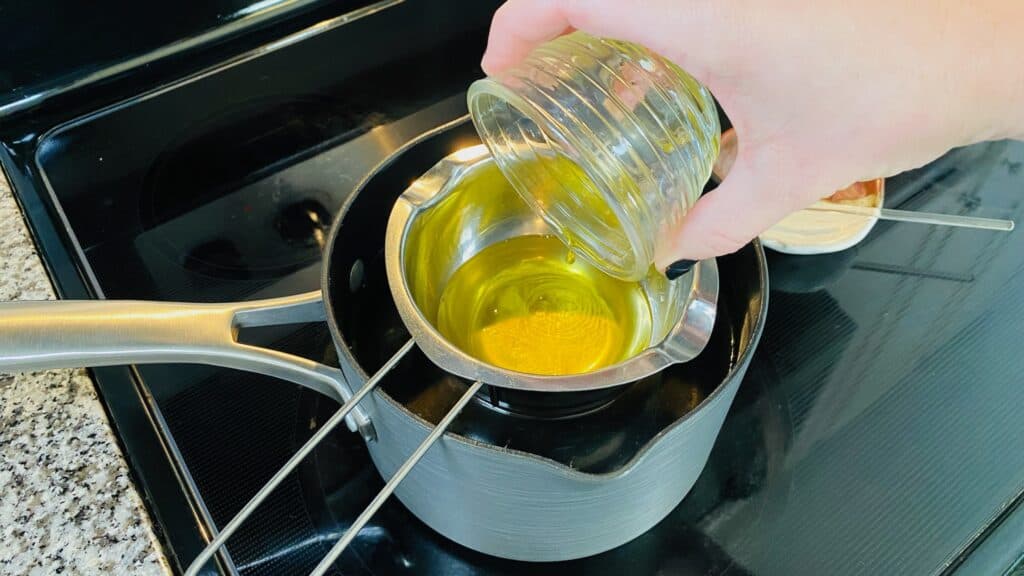
Add organic shea butter and stir until melted. If needed, you may place it back on low heat momentarily to fully melt. Remove from the heat as soon as melted.
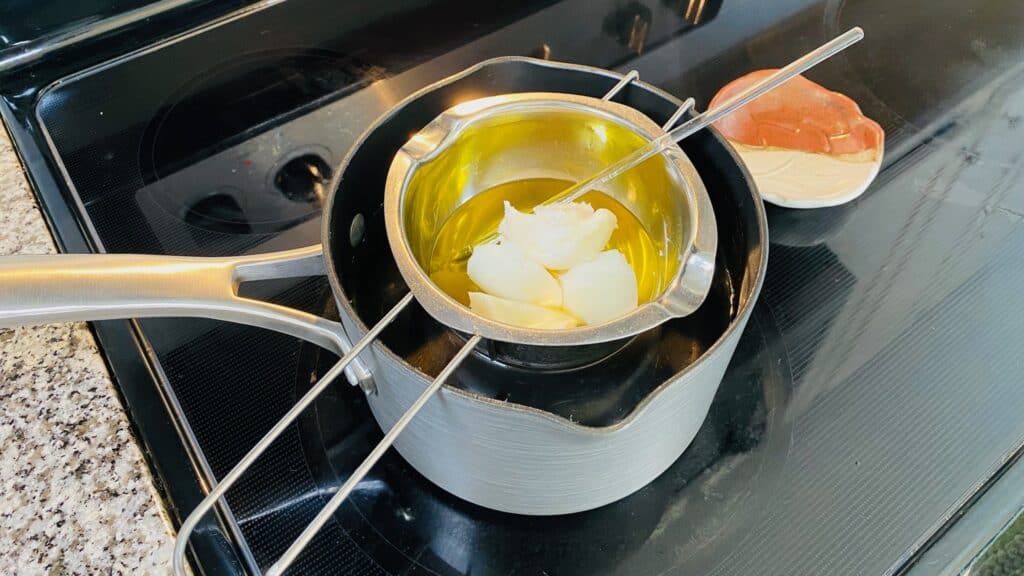
Pour melted ingredients into product containers (see suggestions below). Transfer to a refrigerator if desired.

After solidified, label and safety seal according to your business branding.
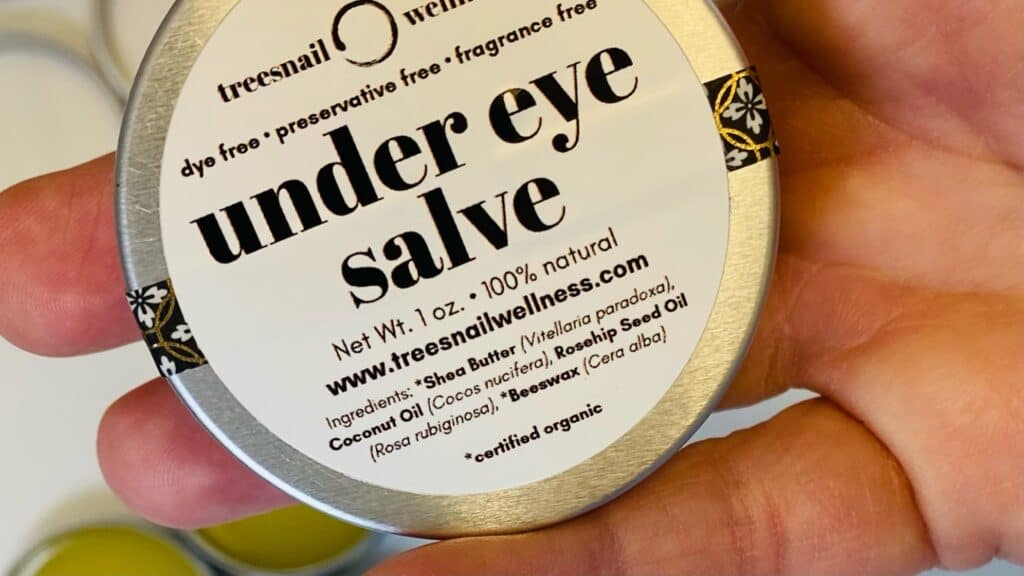
Can I Add Essential Oils to This Under-Eye Salve Recipe?
You will find many DIY recipes online that suggest using essential oils in skin products, but as a certified aromatherapist, I offer a word of caution in this particular recipe.
This under-eye salve is meant to be massaged into the skin around the eyes, which is the home of very thin and delicate skin.
Essential oils are very concentrated, even when diluted with carrier oils or butters. If applied directly to this area, they can cause a burning sensation in your eyes and you could damage the surface of your eye while washing out whatever essential oil gets into your eye.
The combination of unrefined butters and oils in this recipe is very effective without the inclusion of essential oils – if it’s not broke, don’t try to fix it, hmm?
I do recommend using essential oils at a 1% dilution rate for other face products (such as face serum) that are a bit further from the eye.
Consider creating both under-eye salve AND natural face serums for your skin care business, offering them as a bundle to keep your customers safe, e-commerce site full, and profits up.
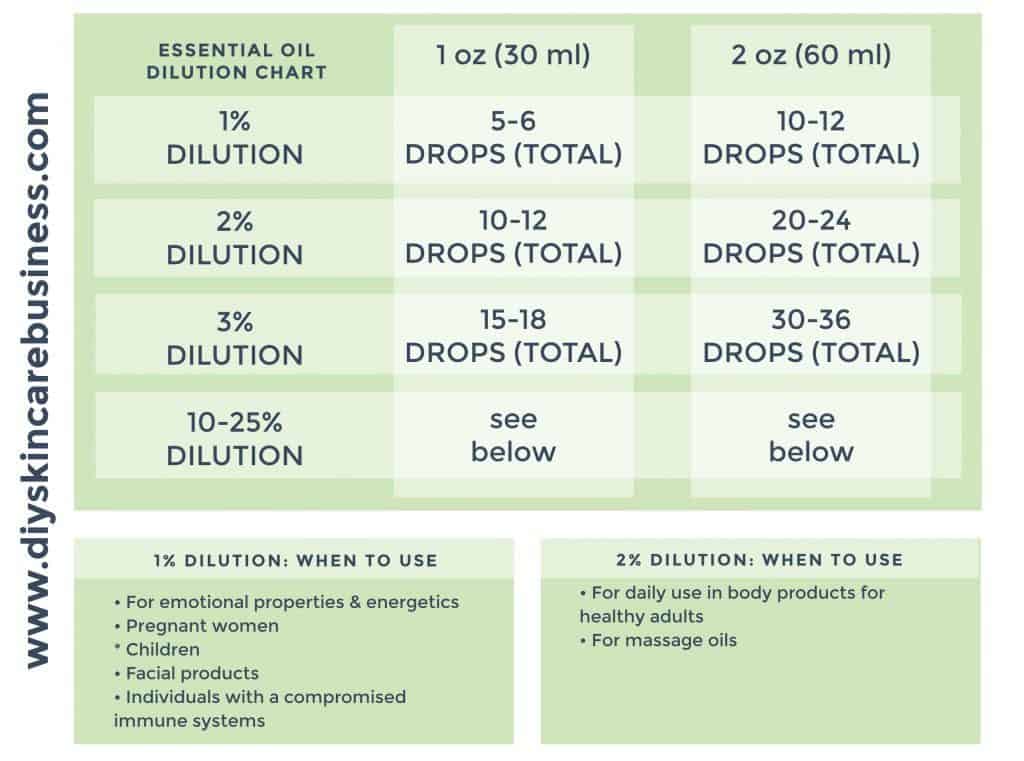
Get a copy of this essential oil dilution chart in the free Skin Care Maker’s Reference Pack here.
Under-Eye Salve Product Packaging Ideas
This organic under-eye salve recipe has a thick, scoopable consistency, which means it needs to be packaged in a wide-mouth, sealable container.
This is best achieved through an aluminum tin or a glass jar.
Before deciding which one to go with, consider the rest of your branding (if you have other skin care products already) and what would make sense for your specific target market.
Aluminum Tins
Aluminum tins are a great container for your under-eye salve, and they are super affordable for you (and your customer!).
The best thing about these is they can be cross-purposed for other products in your line, such as this all-purpose salve or new tattoo care formulations.
Glass Jars
Glass jars make another great option for under-eye salve, and are attractive to target markets that have a bit of a higher budget.
Since this recipe doesn’t include essential oils, using clear glass is okay – if you use essential oils in other formulations, keep in mind that those should be in darker-colored containers to reduce oxidation.
Regardless of the container type you choose, you will need a way to tamper-proof seal it for customer peace of mind and professional aesthetic.
Again considering your target market, the two below are the most popular approaches to tamper-proofing skin care containers.
Shrink Wrap Bands
Shrink wrap is a professional way to seal your containers and is easy and affordable to do.
These shrink wrap bands are just an example, please note that you’ll have to measure your container to know which size is correct.
You’ll also need a heat gun to get the plastic to shrink around your product.
Washi Tape
A less common approach is using colorful washi tape, or similar item in metallics or fibrous textures.
This allows you to really set your brand apart and be memorable.
Applying a detail such as this is more time-intensive than shrink wrap, but could be a factor in customer retention.
How to Create Product Labels for Your Under-Eye Salve
To create product labels for your under-eye salve, you need a graphic design program, a label supplier, and a printer if you’ll be printing them from home yourself.
Of all the graphic design programs out there, Canva is the most popular. This is an easy-to-learn platform with tons of tutorials, design elements, and template features.
If graphic design isn’t your favorite pastime, be sure to check out these editable skin care product label templates that are completely customizable to fit your brand
After downloading your label design from Canva, you’ll navigate over to Avery to put the design on the size of label that fits your product container.
You can either purchase blank labels from Avery to print on your own at home, or get them professionally printed and sent to you ready to apply.
- If you’re just starting out, I recommend ordering blank labels and printing one sheet at a time until you figure out what is going to sell the best in your shop.
- More established skin care businesses that already know their best-sellers and want to save with bulk orders or need premium labels can get custom printing through Avery WePrint.
Get a sneak-peak at what this process looks in our blog post that shows exactly how to print skincare product labels from Canva to Avery.
More Skin Care Business Tips!
If you are just starting out on your handmade business journey, you have found the right place with the right resources to guide your way!
Find more branding tips for your skin care business here, join our private community Facebook group, and sign up for our weekly newsletter to get approachable inspiration.
Be sure to cruise through the resources below to fast-track your progress!
Grow Your Skin Care Business!
Browse through the resources below to boost your handmade business visibility and profitability!


